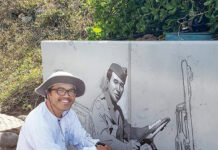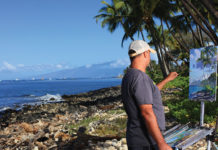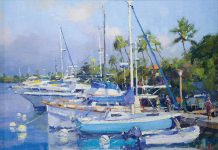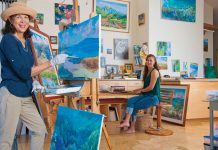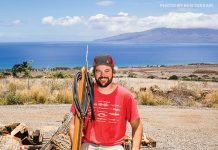Rita Goldman
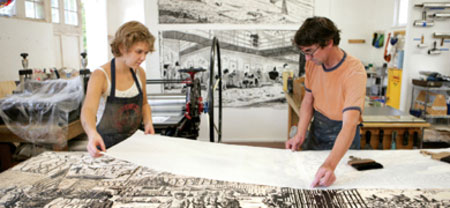 There’s an old coach house on the circular drive that leads to the front door of Kaluanui, the Upcountry mansion designed in 1917 by renowned Hawai‘i architect C.W. Dickey. The home belonged to plantation owner Harry Baldwin and his wife, Ethel, a doyenne of Maui society. You can almost picture the horse-drawn carriages, and later the tin lizzies, that would have emerged from behind the coach house’s weathered wooden doors to wait in the shelter of the mansion’s porte cochere for its passengers to sally forth.
There’s an old coach house on the circular drive that leads to the front door of Kaluanui, the Upcountry mansion designed in 1917 by renowned Hawai‘i architect C.W. Dickey. The home belonged to plantation owner Harry Baldwin and his wife, Ethel, a doyenne of Maui society. You can almost picture the horse-drawn carriages, and later the tin lizzies, that would have emerged from behind the coach house’s weathered wooden doors to wait in the shelter of the mansion’s porte cochere for its passengers to sally forth.
Ethel was an amateur artist. In 1934, she and several lady friends established a little club they called Hui No‘eau—“a gathering of skillful hands”—and would meet at Kaluanui to create art. By 1976, Hui No‘eau had grown into a visual arts society open to the larger Maui community. Since then, the nonprofit organization has been preserving the past while looking to the future.
Slip past the coach house’s sliding doors and you’ll meet a man who epitomizes that pull of tradition and promise. Paul Mullowney heads HuiPress, the fine-art print shop that currently occupies the venerable structure. In the two short years of its existence, HuiPress has begun to put its parent organization on the national map.
Mullowney creates large-scale woodblock prints: edgy, figurative work that he’s shown in Japan and on the U.S. Mainland. But ask him to talk about his art, and the master printer invariably brings the conversation back around to HuiPress. No false modesty here; the work that sustains him is collaboration with some of the most significant artists in the country, names like Judy Pfaff, Robert Kushner, Sally French, Joyce Kozloff and Lothar Osterburg.
“HuiPress is a print studio with a residency program,” Mullowney says. “Our mission is to unlock creativity. We invite five to seven artists a year to come here to create art that pushes the boundaries of printmaking.”
Innovative printmaking? One glance around the shop’s interior is enough to raise a skeptical eyebrow. Where antique vehicles once resided sit vestiges of an even older technology: three etching presses and a lithography press. Only one is motorized; the vast majority of art that gets made here is done the old-fashioned way: manually, laboriously, using low-tech, time-consuming methods. Mullowney, whose wiry frame barely contains his spring-loaded energy, acknowledges the irony. Printmaking is an ancient art, he says, one that’s remained pretty much unchanged since the Renaissance.
We’re not talking about computer- generated reproductions created from photographs of paintings, but fine-art prints, each one an original. Mullowney explains: “The artists work directly on the wood panel or metal plate. Almost always their medium is something else: painting, photography, sculpture. . . . Printmaking is new for them.”
For many, having a collaborator in the creative process is equally new—and potentially scary. Somebody else is going to be applying the colors, running the presses, helping to carve the wood or etch the metal plate that carries the image. Why would any artist in his right mind give up such control?
“People find it exciting to be a beginner again,” says Mullowney. “It frees them from the daily grind and expands their way of making art.”
One who enjoys that challenge is Brad Brown, a New York artist on his second HuiPress residency. “I paint and draw, but I’m always looking at other disciplines,” he says. “The way prints are put together is wildly different than how a painting or drawing is put together. There’s agility in a print. I can work on three copperplates and make a print using all three in a certain color, then another using a different color. It’s the same image, but you can change it and have both versions. You can’t radically change a drawing and have what it was before.
“As a painter, I’m a hermit. Working with Paul in the studio, I have to talk. Paul listens. He knows exactly what needs to be done technically to get a certain look or make half-developed ideas come to life. It’s very collaborative and liberating. And that liberation is what I come back to my own studio with.”
This relationship between artist and printer has been going on for a very long time in Eastern and Western art, says Mullowney. “Since Impressionism, at least, almost all the great artists have worked in this way: Picasso, Lautrec, Manet, Monet. . . .”
Balancing the artist residencies is an internship program that welcomes students from around the country. The evening Brad Brown gives a talk about the latest work he’s doing at HuiPress, Mullowney introduces two interns: a young woman studying at the City University of New York, and a still younger woman, a student at nearby King Kekaulike High School. HuiPress also maintains a strong relationship with the Rhode Island School of Design, Portland’s Pacific Northwest College of Art, the University of Kansas, and, closer to home, the University of Hawai‘i, Maui Community College, Kamehameha Schools and Seabury Hall. One veteran of the internship program, Rhode Island graduate Casey Neumann, now works as head printer for HuiPress.
Interns have to show a passion for learning and a willingness to work hard. In exchange, they receive the rare opportunity to work with a master printer and major artists. Several HuiPress graduates now work in top studios around the country.
Mullowney himself is a product of one of those studios. He earned his chops as a master printer at San Francisco’s prestigious Crown Point Press.
“My grandfather was a commercial lithographer, my father a newspaper publisher. I hung out with them when I was young, and the smell of the ink and the presses got to me.
“I always wanted to be an artist. I studied photography, but I didn’t like the darkroom. With photography, you know what you want. Printmaking is about the process. You start with an idea and it almost always changes. The printer’s job is to control the process as much as possible, but you’re dealing with organic, natural materials: metal, stone, wood, acid. The outcome can never be guaranteed.”
At Crown Point Press, Mullowney worked with John Cage, an artist better known as one of this country’s most innovative composers. “His philosophy came out of Buddhism and randomness and the uncontrollable aspect of everything we do,” says Mullowney. “It was a major influence in my own art.”
In the 1990s, Mullowney and his wife, Cathie Byrne, worked as caretakers at Tokugenji, a seventeenth-century Zen temple in Nara, Japan. There Mullowney founded Tokugenji Press, working with Japanese papermakers and scroll mounters for ten years. The collaboration gave him a knowledge of Japanese papers and techniques few other print shops can offer.
“There’s a reticence among many artists to try Japanese papers, because of the erroneous assumption that they’re hard to print on, and printmaking is challenging enough. But Japanese papers are beautiful, tactile and evocative, and super strong. If I think the work would be enhanced by Asian papers, I’ll pull a proof and let the artist see.”
Once the artist signs off on the proof and heads home, Mullowney, Neumann and HuiPress interns settle into the task of publishing an edition. “You can make only ten to thirty prints before the plates wear out,” he says. “We consider each an original. Because it’s done by hand, there are variations with each print we pull.” Even with so small a run, editioning a work of art can take a month to a year to complete.
LA artist Sandow Birk created two major projects at HuiPress—intricate and metaphorical series that have shown in galleries on both coasts.
“The most recent was a series of woodcuts about the war in Iraq,” says Birk. “When I began the project, I thought of doing really small etchings. Paul suggested woodblocks, and making them four by eight feet, the biggest panel you can buy. The technique of woodcut is blocky and aggressive and scratchy, which goes better conceptually with the subject of warfare than delicate etchings.
“It took several of us to carve the blocks. I did small drawings, and Paul blew them up and used them as a guide. He showed us how to use the tools, and five or six people worked on them for over six months.
“Paul never says no,” Birk adds, “even if you come up with something impractical. He wants to do serious, interesting, meaningful projects, regardless of whether they’ll bring in money. It’s hard to find people willing to do that.”
Brad Brown agrees. “I’m excited over what Paul has put together. The attitude at HuiPress is free and playful. And with the carriage house doors open, all of Maui comes in on the breeze.”

